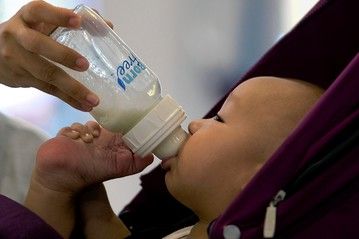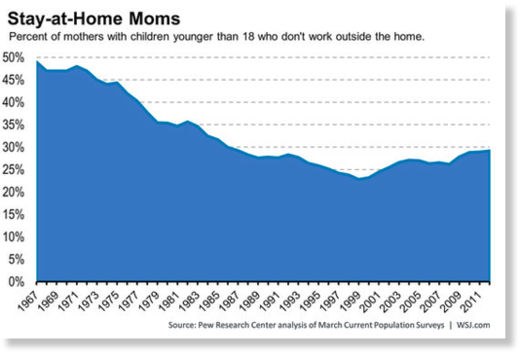After decades of decline, the share of mothers who
stay home with their children has steadily risen over the last several years, a new report has found.
In 2012, 29% of all mothers with children under age 18 stayed at home, a figure that has steadily risen since 1999 when 23% of mothers were stay-at-home, the
Pew Research Center reported Tuesday. The share of stay-at-home moms had been dropping since 1967, when about half of all moms stayed home.
Pew attributed the rise of stay-at-home mothers to a mix of demographic, economic and societal factors. The vast majority of married stay-at-home mothers, 85%, say they are doing so by choice in order to care for their families. That rate is much lower for single stay-at-home mothers, at 41%, and cohabitating mothers, at 64%.
The report also found a drop in women working because of the recession, a trend that has lingered as the economy recovers. Pew cited an increase in immigrant families, for whom it is more common to have a mother stay at home with her children, and an increase in the number of women who said they were disabled and unable to work.
A companion public opinion survey by Pew, from 2013, found that mothers are much more likely than fathers to have reduced work hours, take a significant amount of time off, quit a job or, by a small margin, turn down a promotion in order to care for a child or family member. Pew said 42% of mothers said they had reduced their work hours to care for a child or family member, versus 28% of fathers.
A second Pew survey, taken this year, found most in the general public think that children are better off with a parent at home: 60% said children are better off with a parent at home, versus 35% who said kids are just as well off when parents work.
The survey of 3,341 people was conducted in January and February. Groups most likely to say kids are better off with a parent at home include Hispanics, people with a high school degree or less and evangelical Christians, the report said.
The Pew analysis of trends for stay-at-home moms is based on an analysis of data from the
Census Bureau's Current Population Survey. It defines stay-at-home mothers as those who say they are staying home in order to care for their children, as well as those who are not able to find work, are disabled or are enrolled in school.

© Associated Press
"This has important implications for the day to day lives of children," said
D'Vera Cohn, the report's author.
The share of stay-at-home mothers is now higher than it was during the recession in 2008, when it reached 26%. About 6% of moms say they are home because they can't find a job, up from just 1% in 2000.The report didn't find lots more college-educated mothers dropping out of the workforce to spend time with their kids.
In 2000, 20% of college-educated mothers were at home, compared to 2012 when it was 21%. Ms. Cohn said college-educated workers have done much better in the economy, helping to explain why they might stay in the workforce.The report also looked at how stay-at-home versus working moms use their time. Those at home spend more time on housework (23 hours per week versus 14 for working mothers), child care (18 hours vs. 11), leisure (31 hours vs. 22) and sleep (63 hours vs. 58 for working mothers).


Reader Comments
to our Newsletter